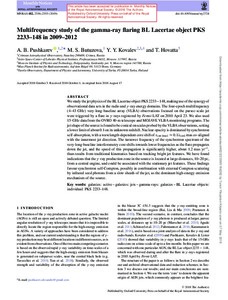Multifrequency study of the gamma-ray flaring BL Lacertae object PKS 2233-148 in 2009-2012
A. B. Pushkarev; M. S. Butuzova; Y. Y. Kovalev; T. Hovatta
Multifrequency study of the gamma-ray flaring BL Lacertae object PKS 2233-148 in 2009-2012
A. B. Pushkarev
M. S. Butuzova
Y. Y. Kovalev
T. Hovatta
OXFORD UNIV PRESS
Julkaisun pysyvä osoite on:
https://urn.fi/URN:NBN:fi-fe2021042713676
https://urn.fi/URN:NBN:fi-fe2021042713676
Tiivistelmä
We study the jet physics of the BL Lacertae object PKS 2233-148, making use of the synergy of observational data sets in the radio and gamma-ray energy domains. The four-epoch multifrequency (4-43 GHz) very-long-baseline array (VLBA) observations focused on the parsec-scale jet were triggered by a flare in gamma-rays registered by Fermi-LAT on 2010 April 23. We also used 15-GHz data from the OVRO 40-m telescope and MOJAVE VLBA monitoring programs. The jet shape of the source is found to be conical on scales probed by the VLBA observations, setting a lower limit of about 0.1 on its unknown redshift. Nuclear opacity is dominated by synchrotron self-absorption, with a wavelength-dependent core shift of r(core) ([mas]) approximate to 0.1 lambda[cm] mas co-aligned with the innermost jet direction. The turnover frequency of the synchrotron spectrum of the very-long-baseline interferometry core shifts towards lower frequencies as the flare propagates down the jet, and the speed of this propagation is significantly higher, about 1.2 mas yr(-1), than results from traditional kinematics based on tracking bright jet features. We have found indications that the gamma-ray production zone in the source is located at large distances, 10-20 pc, from a central engine, and could be associated with the stationary jet features. These findings favour synchrotron self-Compton, possibly in combination with external Compton scattering by infrared seed photons from a slow sheath of the jet, as the dominant high-energy emission mechanism of the source.
Kokoelmat
- Rinnakkaistallenteet [27094]
